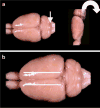Targeting the choroid plexus-CSF-brain nexus using peptides identified by phage display
- PMID: 21082389
- PMCID: PMC4224277
- DOI: 10.1007/978-1-60761-938-3_25
Targeting the choroid plexus-CSF-brain nexus using peptides identified by phage display
Abstract
Drug delivery to the central nervous system requires the use of specific portals to enable drug entry into the brain and, as such, there is a growing need to identify processes that can enable drug transfer across both blood-brain and blood-cerebrospinal fluid barriers. Phage display is a powerful combinatorial technique that identifies specific peptides that can confer new activities to inactive particles. Identification of these peptides is directly dependent on the specific screening strategies used for their selection and retrieval. This chapter describes three selection strategies, which can be used to identify peptides that target the choroid plexus (CP) directly or for drug translocation across the CP and into cerebrospinal fluid.
Figures




Similar articles
-
Targeting choroid plexus epithelia and ventricular ependyma for drug delivery to the central nervous system.BMC Neurosci. 2011 Jan 7;12:4. doi: 10.1186/1471-2202-12-4. BMC Neurosci. 2011. PMID: 21214926 Free PMC article.
-
Leptin transport at the blood--cerebrospinal fluid barrier using the perfused sheep choroid plexus model.Brain Res. 2001 Mar 23;895(1-2):283-90. doi: 10.1016/s0006-8993(01)02116-3. Brain Res. 2001. PMID: 11259792
-
Enhanced prospects for drug delivery and brain targeting by the choroid plexus-CSF route.Pharm Res. 2005 Jul;22(7):1011-37. doi: 10.1007/s11095-005-6039-0. Epub 2005 Jul 22. Pharm Res. 2005. PMID: 16028003 Review.
-
Role of cationic drug-sensitive transport systems at the blood-cerebrospinal fluid barrier in para-tyramine elimination from rat brain.Fluids Barriers CNS. 2018 Jan 8;15(1):1. doi: 10.1186/s12987-017-0087-9. Fluids Barriers CNS. 2018. PMID: 29307307 Free PMC article.
-
The distributional nexus of choroid plexus to cerebrospinal fluid, ependyma and brain: toxicologic/pathologic phenomena, periventricular destabilization, and lesion spread.Toxicol Pathol. 2011 Jan;39(1):186-212. doi: 10.1177/0192623310394214. Epub 2010 Dec 28. Toxicol Pathol. 2011. PMID: 21189316 Review.
Cited by
-
Esophageal cancer related gene-4 is a choroid plexus-derived injury response gene: evidence for a biphasic response in early and late brain injury.PLoS One. 2011;6(9):e24609. doi: 10.1371/journal.pone.0024609. Epub 2011 Sep 14. PLoS One. 2011. PMID: 21935431 Free PMC article.
-
ABC Transporters at the Blood-Brain Interfaces, Their Study Models, and Drug Delivery Implications in Gliomas.Pharmaceutics. 2019 Dec 23;12(1):20. doi: 10.3390/pharmaceutics12010020. Pharmaceutics. 2019. PMID: 31878061 Free PMC article. Review.
-
In Vitro Models of the Blood-Cerebrospinal Fluid Barrier and Their Applications in the Development and Research of (Neuro)Pharmaceuticals.Pharmaceutics. 2022 Aug 18;14(8):1729. doi: 10.3390/pharmaceutics14081729. Pharmaceutics. 2022. PMID: 36015358 Free PMC article. Review.
-
Intravenous phage display identifies peptide sequences that target the burn-injured intestine.Peptides. 2012 Nov;38(1):94-9. doi: 10.1016/j.peptides.2012.08.015. Epub 2012 Aug 30. Peptides. 2012. PMID: 22960048 Free PMC article.
-
A novel CNS-homing peptide for targeting neuroinflammatory lesions in experimental autoimmune encephalomyelitis.Mol Cell Probes. 2020 Jun;51:101530. doi: 10.1016/j.mcp.2020.101530. Epub 2020 Feb 5. Mol Cell Probes. 2020. PMID: 32035108 Free PMC article.
References
-
- Smith GP. Filamentous fusion phage: novel expression vectors that display cloned antigens on the virion surface. Science. 1985;228:1315–1317. - PubMed
-
- Barbas CF. Phage display: a laboratory manual. Cold Spring Harbor: Cold Spring Harbor Laboratory; 2001.
-
- Pasqualini R, Arap W, McDonald DM. Probing the structural and molecular diversity of tumor vasculature. Trends Mol Med. 2002;8:563–571. - PubMed
-
- Larocca D, Baird A. Receptor-mediated gene transfer by phage-display vectors: applications in functional genomics and gene therapy. Drug Discov Today. 2001;6:793–801. - PubMed
-
- Larocca D, Burg MA, Jensen-Pergakes K, Ravey EP, Gonzalez AM, Baird A. Evolving phage vectors for cell targeted gene delivery. Curr Pharm Biotechnol. 2002;3:45–57. - PubMed
Publication types
MeSH terms
Substances
Grants and funding
LinkOut - more resources
Full Text Sources
Other Literature Sources
Miscellaneous

